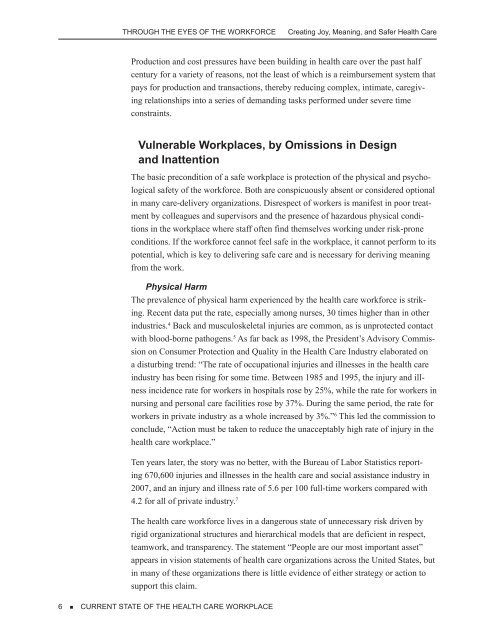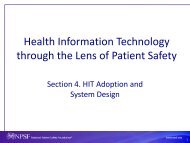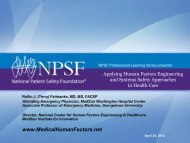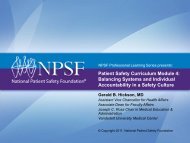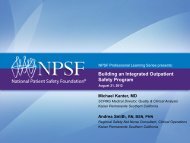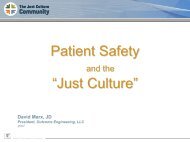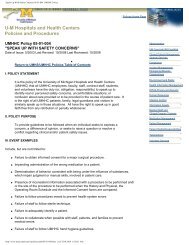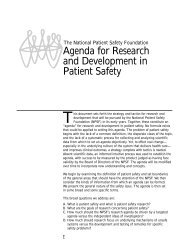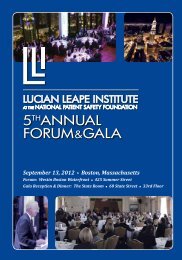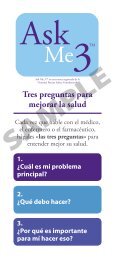Through The eyes of The Workforce - National Patient Safety ...
Through The eyes of The Workforce - National Patient Safety ...
Through The eyes of The Workforce - National Patient Safety ...
Create successful ePaper yourself
Turn your PDF publications into a flip-book with our unique Google optimized e-Paper software.
THROUGH THE EYES OF THE WORKFORCECreating Joy, Meaning, and Safer Health CareProduction and cost pressures have been building in health care over the past halfcentury for a variety <strong>of</strong> reasons, not the least <strong>of</strong> which is a reimbursement system thatpays for production and transactions, thereby reducing complex, intimate, caregivingrelationships into a series <strong>of</strong> demanding tasks performed under severe timeconstraints.Vulnerable Workplaces, by Omissions in Designand Inattention<strong>The</strong> basic precondition <strong>of</strong> a safe workplace is protection <strong>of</strong> the physical and psychologicalsafety <strong>of</strong> the workforce. Both are conspicuously absent or considered optionalin many care-delivery organizations. Disrespect <strong>of</strong> workers is manifest in poor treatmentby colleagues and supervisors and the presence <strong>of</strong> hazardous physical conditionsin the workplace where staff <strong>of</strong>ten find themselves working under risk-proneconditions. If the workforce cannot feel safe in the workplace, it cannot perform to itspotential, which is key to delivering safe care and is necessary for deriving meaningfrom the work.Physical Harm<strong>The</strong> prevalence <strong>of</strong> physical harm experienced by the health care workforce is striking.Recent data put the rate, especially among nurses, 30 times higher than in otherindustries. 4 Back and musculoskeletal injuries are common, as is unprotected contactwith blood-borne pathogens. 5 As far back as 1998, the President’s Advisory Commissionon Consumer Protection and Quality in the Health Care Industry elaborated ona disturbing trend: “<strong>The</strong> rate <strong>of</strong> occupational injuries and illnesses in the health careindustry has been rising for some time. Between 1985 and 1995, the injury and illnessincidence rate for workers in hospitals rose by 25%, while the rate for workers innursing and personal care facilities rose by 37%. During the same period, the rate forworkers in private industry as a whole increased by 3%.” 6 This led the commission toconclude, “Action must be taken to reduce the unacceptably high rate <strong>of</strong> injury in thehealth care workplace.”Ten years later, the story was no better, with the Bureau <strong>of</strong> Labor Statistics reporting670,600 injuries and illnesses in the health care and social assistance industry in2007, and an injury and illness rate <strong>of</strong> 5.6 per 100 full-time workers compared with4.2 for all <strong>of</strong> private industry. 7<strong>The</strong> health care workforce lives in a dangerous state <strong>of</strong> unnecessary risk driven byrigid organizational structures and hierarchical models that are deficient in respect,teamwork, and transparency. <strong>The</strong> statement “People are our most important asset”appears in vision statements <strong>of</strong> health care organizations across the United States, butin many <strong>of</strong> these organizations there is little evidence <strong>of</strong> either strategy or action tosupport this claim.6 • CURRENT STATE OF THE HEALTH CARE WORKPLACE


